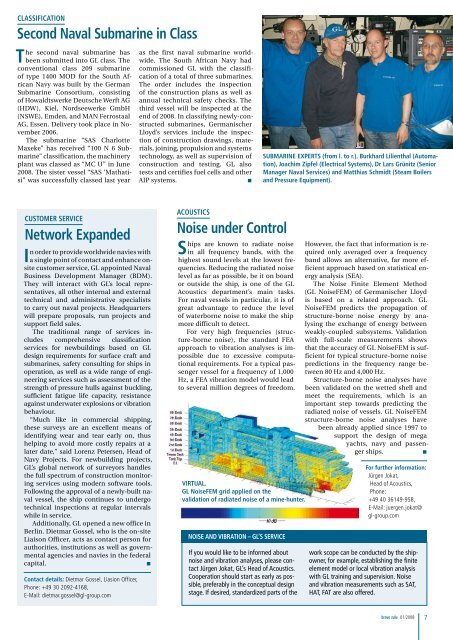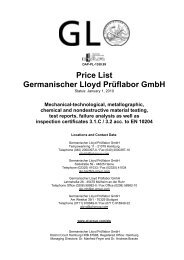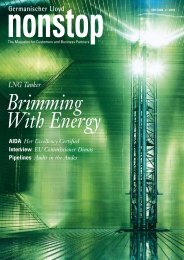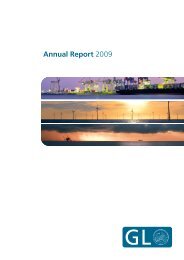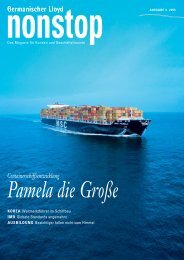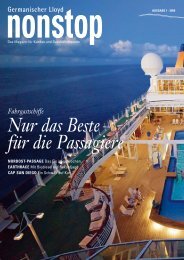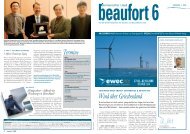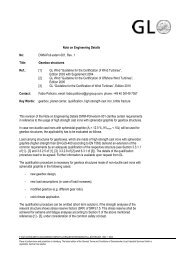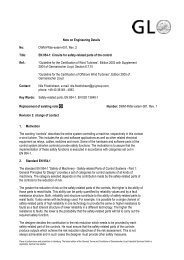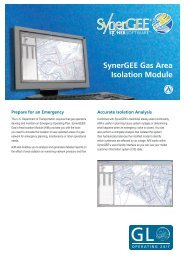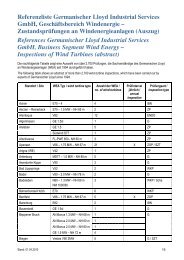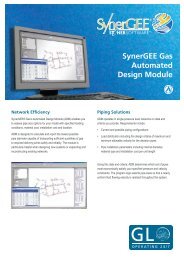bravo zulu 1/2008 - GL Group
bravo zulu 1/2008 - GL Group
bravo zulu 1/2008 - GL Group
You also want an ePaper? Increase the reach of your titles
YUMPU automatically turns print PDFs into web optimized ePapers that Google loves.
claSSIFIcaTIon<br />
Second naval Submarine in class<br />
The second naval submarine has<br />
been submitted into <strong>GL</strong> class. The<br />
conventional class 209 submarine<br />
of type 1400 MOD for the South African<br />
Navy was built by the German<br />
Submarine Consortium, consisting<br />
of Howaldtswerke Deutsche Werft AG<br />
(HDW), Kiel, Nordseewerke GmbH<br />
(NSWE), Emden, and MAN Ferrostaal<br />
AG, Essen. Delivery took place in November<br />
2006.<br />
The submarine “SAS Charlotte<br />
Maxeke” has received “100 N 6 Submarine”<br />
classification, the machinery<br />
plant was classed as “MC U” in June<br />
<strong>2008</strong>. The sister vessel “SAS ‘Mathatisi”<br />
was successfully classed last year<br />
cUSTomER SERVIcE<br />
network Expanded<br />
In order to provide worldwide navies with<br />
a single point of contact and enhance onsite<br />
customer service, <strong>GL</strong> appointed Naval<br />
Business Development Manager (BDM).<br />
They will interact with <strong>GL</strong>’s local representatives,<br />
all other internal and external<br />
technical and administrative specialists<br />
to carry out naval projects. Headquarters<br />
will prepare proposals, run projects and<br />
support field sales.<br />
The traditional range of services includes<br />
comprehensive classification<br />
services for newbuildings based on <strong>GL</strong><br />
design requirements for surface craft and<br />
submarines, safety consulting for ships in<br />
operation, as well as a wide range of engineering<br />
services such as assessment of the<br />
strength of pressure hulls against buckling,<br />
sufficient fatigue life capacity, resistance<br />
against underwater explosions or vibration<br />
behaviour.<br />
“Much like in commercial shipping,<br />
these surveys are an excellent means of<br />
identifying wear and tear early on, thus<br />
helping to avoid more costly repairs at a<br />
later date,” said Lorenz Petersen, Head of<br />
Navy Projects. For newbuilding projects,<br />
<strong>GL</strong>’s global network of surveyors handles<br />
the full spectrum of construction monitoring<br />
services using modern software tools.<br />
Following the approval of a newly-built naval<br />
vessel, the ship continues to undergo<br />
technical inspections at regular intervals<br />
while in service.<br />
Additionally, <strong>GL</strong> opened a new office in<br />
Berlin. Dietmar Gossel, who is the on-site<br />
Liaison Officer, acts as contact person for<br />
authorities, institutions as well as governmental<br />
agencies and navies in the federal<br />
capital. ■<br />
contact details: Dietmar Gossel, Liasion Officer,<br />
Phone: +49 30 2092-4168,<br />
E-Mail: dietmar.gossel@gl-group.com<br />
as the first naval submarine worldwide.<br />
The South African Navy had<br />
commissioned <strong>GL</strong> with the classification<br />
of a total of three submarines.<br />
The order includes the inspection<br />
of the construction plans as well as<br />
annual technical safety checks. The<br />
third vessel will be inspected at the<br />
end of <strong>2008</strong>. In classifying newly-constructed<br />
submarines, Germanischer<br />
Lloyd’s services include the inspection<br />
of construction drawings, materials,<br />
joining, propulsion and systems<br />
technology, as well as supervision of<br />
construction and testing. <strong>GL</strong> also<br />
tests and certifies fuel cells and other<br />
AIP systems. ■<br />
acoUSTIcS<br />
noise under control<br />
Ships are known to radiate noise<br />
in all frequency bands, with the<br />
highest sound levels at the lowest frequencies.<br />
Reducing the radiated noise<br />
level as far as possible, be it on board<br />
or outside the ship, is one of the <strong>GL</strong><br />
Acoustics department’s main tasks.<br />
For naval vessels in particular, it is of<br />
great advantage to reduce the level<br />
of waterborne noise to make the ship<br />
more difficult to detect.<br />
For very high frequencies (structure-borne<br />
noise), the standard FEA<br />
approach to vibration analyses is impossible<br />
due to excessive computational<br />
requirements. For a typical passenger<br />
vessel for a frequency of 1,000<br />
Hz, a FEA vibration model would lead<br />
to several million degrees of freedom.<br />
VIRTUal.<br />
gl noiseFEm grid applied on the<br />
validation of radiated noise of a mine-hunter.<br />
noISE and VIBRaTIon – gl’S SERVIcE<br />
If you would like to be informed about<br />
noise and vibration analyses, please contact<br />
Jürgen Jokat, <strong>GL</strong>’s Head of Acoustics.<br />
Cooperation should start as early as possible,<br />
preferably in the conceptual design<br />
stage. If desired, standardized parts of the<br />
SUBmaRInE EXpERTS (from l. to r.). Burkhard lilienthal (automation),<br />
Joachim Zipfel (Electrical Systems), dr lars grünitz (Senior<br />
manager naval Services) and matthias Schmidt (Steam Boilers<br />
and pressure Equipment).<br />
However, the fact that information is required<br />
only averaged over a frequency<br />
band allows an alternative, far more efficient<br />
approach based on statistical energy<br />
analysis (SEA).<br />
The Noise Finite Element Method<br />
(<strong>GL</strong> NoiseFEM) of Germanischer Lloyd<br />
is based on a related approach. <strong>GL</strong><br />
NoiseFEM predicts the propagation of<br />
structure-borne noise energy by analysing<br />
the exchange of energy between<br />
weakly-coupled subsystems. Validation<br />
with full-scale measurements shows<br />
that the accuracy of <strong>GL</strong> NoiseFEM is sufficient<br />
for typical structure-borne noise<br />
predictions in the frequency range between<br />
80 Hz and 4,000 Hz.<br />
Structure-borne noise analyses have<br />
been validated on the wetted shell and<br />
meet the requirements, which is an<br />
important step towards predicting the<br />
radiated noise of vessels. <strong>GL</strong> NoiseFEM<br />
structure-borne noise analyses have<br />
been already applied since 1997 to<br />
support the design of mega<br />
yachts, navy and passenger<br />
ships. ■<br />
For further information:<br />
Jürgen Jokat,<br />
Head of Acoustics,<br />
Phone:<br />
+49 40 36149-9 8,<br />
E-Mail: juergen.jokat@<br />
gl-group.com<br />
work scope can be conducted by the shipowner,<br />
for example, establishing the finite<br />
element model or local vibration analysis<br />
with <strong>GL</strong> training and supervision. Noise<br />
and vibration measurements such as SAT,<br />
HAT, FAT are also offered.<br />
<strong>bravo</strong> <strong>zulu</strong> 01/<strong>2008</strong> 7


